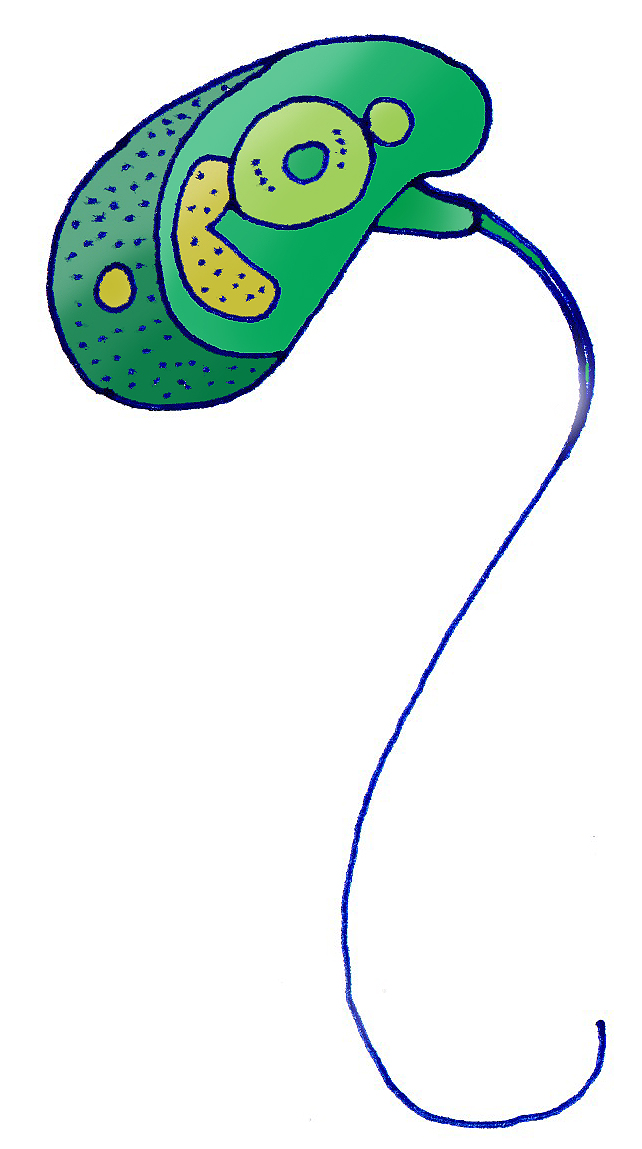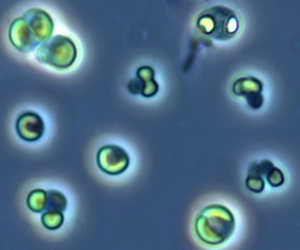|
Chlorophyta
Chlorophyta or Prasinophyta is a taxon of green algae informally called chlorophytes. The name is used in two very different senses, so care is needed to determine the use by a particular author. In older classification systems, it refers to a highly paraphyletic group of ''all'' the green algae within the green plants (Viridiplantae) and thus includes about 7,000 species of mostly aquatic photosynthetic eukaryotic organisms. In newer classifications, it refers to the sister clade of the streptophytes/ charophytes. The clade Streptophyta consists of the Charophyta in which the Embryophyta (land plants) emerged. In this latter sense the Chlorophyta includes only about 4,300 species. About 90% of all known species live in freshwater. Like the land plants (embryophytes: bryophytes and tracheophytes), green algae (chlorophytes and charophytes besides embryophytes) contain chlorophyll a and chlorophyll b and store food as starch in their plastids. With the exception of Palmop ... [...More Info...] [...Related Items...] OR: [Wikipedia] [Google] [Baidu] |
Green Algae
The green algae (singular: green alga) are a group consisting of the Prasinodermophyta and its unnamed sister which contains the Chlorophyta and Charophyta/Streptophyta. The land plants (Embryophytes) have emerged deep in the Charophyte alga as sister of the Zygnematophyceae. Since the realization that the Embryophytes emerged within the green algae, some authors are starting to properly include them. The completed clade that includes both green algae and embryophytes is monophyletic and is referred to as the clade Viridiplantae and as the kingdom Plantae. The green algae include unicellular and colonial flagellates, most with two flagella per cell, as well as various colonial, coccoid and filamentous forms, and macroscopic, multicellular seaweeds. There are about 22,000 species of green algae. Many species live most of their lives as single cells, while other species form coenobia (colonies), long filaments, or highly differentiated macroscopic seaweeds. A few other organi ... [...More Info...] [...Related Items...] OR: [Wikipedia] [Google] [Baidu] |
Charophyta
Charophyta () is a group of freshwater green algae, called charophytes (), sometimes treated as a division, yet also as a superdivision or an unranked clade. The terrestrial plants, the Embryophyta emerged within Charophyta, possibly from terrestrial unicellular charophytes, with the class Zygnematophyceae as a sister group. The clade Streptophyta may be formed by placing Embryophyta within the Charophyta. The Embryophyta may already be included in the Charophyta, in which case it is a synonym of the Streptophyta. The sister group of the charophytes are the Chlorophyta. In some charophyte groups, such as the Zygnematophyceae or conjugating green algae, flagella are absent and sexual reproduction does not involve free-swimming flagellate sperm. Flagellate sperm, however, are found in stoneworts ( Charales) and Coleochaetales, orders of parenchymatous charophytes that are the closest relatives of the land plants, where flagellate sperm are also present in all except the coni ... [...More Info...] [...Related Items...] OR: [Wikipedia] [Google] [Baidu] |
Prasinophyte
The prasinophytes are a group of unicellular green algae. Prasinophytes mainly include marine planktonic species, as well as some freshwater representatives.Sym, S. D. and Pienaar, R. N. 1993. The class Prasinophyceae. In Round, F. E. and Chapman, D. J. (eds) ''Progress in Phycological Research'', Vol. 9. Biopress Ltd., Bristol, pp. 281-376. The prasinophytes are morphologically diverse, including flagellates with one to eight flagella and non-motile (coccoid) unicells. The cells of many species are covered with organic body scales; others are naked. Well studied genera include ''Ostreococcus'', considered to be the smallest (ca. 0.95 μm) free-living eukaryote, and ''Micromonas'', both of which are found in marine waters worldwide. Prasinophytes have simple cellular structures, containing a single chloroplast and a single mitochondrion. The genomes are relatively small compared to other eukaryotes (about 12 Mbp for ''Ostreococcus'' and 21 Mbp for ''Micromonas''). At least one spe ... [...More Info...] [...Related Items...] OR: [Wikipedia] [Google] [Baidu] |
Prasinophyceae
The prasinophytes are a group of unicellular green algae. Prasinophytes mainly include marine planktonic species, as well as some freshwater representatives.Sym, S. D. and Pienaar, R. N. 1993. The class Prasinophyceae. In Round, F. E. and Chapman, D. J. (eds) ''Progress in Phycological Research'', Vol. 9. Biopress Ltd., Bristol, pp. 281-376. The prasinophytes are morphologically diverse, including flagellates with one to eight flagella and non-motile (coccoid) unicells. The cells of many species are covered with organic body scales; others are naked. Well studied genera include ''Ostreococcus'', considered to be the smallest (ca. 0.95 μm) free-living eukaryote, and ''Micromonas'', both of which are found in marine waters worldwide. Prasinophytes have simple cellular structures, containing a single chloroplast and a single mitochondrion. The genomes are relatively small compared to other eukaryotes (about 12 Mbp for ''Ostreococcus'' and 21 Mbp for ''Micromonas''). At least one spe ... [...More Info...] [...Related Items...] OR: [Wikipedia] [Google] [Baidu] |
Viridiplantae
Viridiplantae (literally "green plants") are a clade of eukaryotic organisms that comprise approximately 450,000–500,000 species and play important roles in both terrestrial and aquatic ecosystems. They are made up of the green algae, which are primarily aquatic, and the land plants (embryophytes), which emerged from within them. Green algae traditionally excludes the land plants, rendering them a paraphyletic group. However it is accurate to think of land plants as a kind of algae. Since the realization that the embryophytes emerged from within the green algae, some authors are starting to include them. They have cells with cellulose in their cell walls, and primary chloroplasts derived from endosymbiosis with cyanobacteria that contain chlorophylls a and b and lack phycobilins. In some classification systems, the group has been treated as a kingdom, under various names, e.g. Viridiplantae, Chlorobionta, or simply Plantae, the latter expanding the traditional plant king ... [...More Info...] [...Related Items...] OR: [Wikipedia] [Google] [Baidu] |
Picocystophyceae
''Picocystis'' is a monotypic genus of green algae, the sole species is ''Picocystis salinarum''. It is placed within its own class, Picocystophyceae in the division Chlorophyta. Structure ''Picocystis salinarum'' cells under normal conditions have a spherical or oval shape. Their size ranges from 2 to 3μm (micrometer, 10^-6) in diameter. Under conditions of nutrient depletion they appear to form a trillobe shape. This trillobe shape gives it the nickname Mickey Mouse, due to its appearance to the famous character's head. The general appearance resembles that of a standard green algae. The pigments are composed mainly from chlorophyll a and b and the carotenoids violaxanthin, alloxanthin, monadoxanthin, neoxanthin, lutein, diatoxanthin and zeaxanthin. The cell wall is mainly composed of polymers of the monosaccharide arabinose, polyarabinose. Habitat The species have been found in saline or hypersaline alkaline In chemistry, an alkali (; from ar, القلوي, ... [...More Info...] [...Related Items...] OR: [Wikipedia] [Google] [Baidu] |
Land Plants
The Embryophyta (), or land plants, are the most familiar group of green plants that comprise vegetation on Earth. Embryophytes () have a common ancestor with green algae, having emerged within the Phragmoplastophyta clade of green algae as sister of the Zygnematophyceae. The Embryophyta consist of the bryophytes plus the polysporangiophytes. Living embryophytes therefore include hornworts, liverworts, mosses, lycophytes, ferns, gymnosperms and flowering plants. The land plants have diplobiontic life cycles and it is accepted now that they emerged from freshwater, multi-celled algae. The embryophytes are informally called land plants because they live primarily in terrestrial habitats (with exceptional members who evolved to live once again in aquatic habitats), while the related green algae are primarily aquatic. Embryophytes are complex multicellular eukaryotes with specialized reproductive organs. The name derives from their innovative characteristic of nurturing the young ... [...More Info...] [...Related Items...] OR: [Wikipedia] [Google] [Baidu] |
Embryophyta
The Embryophyta (), or land plants, are the most familiar group of green plants that comprise vegetation on Earth. Embryophytes () have a common ancestor with green algae, having emerged within the Phragmoplastophyta clade of green algae as sister of the Zygnematophyceae. The Embryophyta consist of the bryophytes plus the polysporangiophytes. Living embryophytes therefore include hornworts, liverworts, mosses, lycophytes, ferns, gymnosperms and flowering plants. The land plants have diplobiontic life cycles and it is accepted now that they emerged from freshwater, multi-celled algae. The embryophytes are informally called land plants because they live primarily in terrestrial habitats (with exceptional members who evolved to live once again in aquatic habitats), while the related green algae are primarily aquatic. Embryophytes are complex multicellular eukaryotes with specialized reproductive organs. The name derives from their innovative characteristic of nurturing the youn ... [...More Info...] [...Related Items...] OR: [Wikipedia] [Google] [Baidu] |
Chloropicophyceae
Chloropicophyceae is a class of green algae in the division Chlorophyta that, along with Picocystophyceae, coincides with the traditional "prasinophyte clade VII". Description Members of this class are coccoid green cells, with a diameter of 1.5–4 µm, found in marine waters, with one nucleus, one mitochondrion, and one chloroplast surrounded by two membranes, containing starch grain; their single chloroplast has chlorophylls '' a'' and '' b''; they lack pyrenoid and flagella; and they have a layered cell wall. Their sexual reproduction is unknown. Taxonomy In total, this class contains eight newly described species, belonging to two genera. The taxonomy goes as follows : *Division Chlorophyta Reichenbach 1834 ** Class Chloropicophyceae Lopes dos Santos & Eikrem 2017 *** Order Chloropicales Lopes dos Santos & Eikrem 2017 **** Family Chloropicaceae Lopes dos Santos & Eikrem 2017 ***** Genus '' Chloropicon'' Lopes dos Santos & Eikrem 2017 ****** ''Chloropicon sieburthii'' L ... [...More Info...] [...Related Items...] OR: [Wikipedia] [Google] [Baidu] |
Chlorodendrophyceae
Chlorodendrales are an order of green, flagellated, thecate, unicellular eukaryotes, within the green algae class Chlorodendrophyceae.Becker, B., Marin, B. and Melkonian, M. 1994: Structure, composition, and biogenesis of prasinophyte cell coverings. Protoplasma. 181: 233-244. 10.1007/BF01666398See the NCBIbr>webpage on Chlorodendrales Data extracted from the Prasinophyceae are defined by their cellular scales which are composed of carbohydrates, and Chlorodendrales are unique within this group due to these scales forming a fused thecal wall. Cells of Chlorodendrales are completely covered in scales, which fuse around the cell body producing the theca, but remain individually separated on the flagella, of which there are typically four per cell. Species within Chlorodendrales live in both marine and fresh water habitats, occupying both benthic and planktonic food webs. Additionally, they are photoautotrophs, meaning they produce their own food through the conversion of sunlight i ... [...More Info...] [...Related Items...] OR: [Wikipedia] [Google] [Baidu] |
Palmophyllophyceae
The Palmophyllophyceae are a proposed basal Chlorophyte clade consisting of the Palmophyllales and Prasinococcales Prasinococcaceae is a family of green algae The green algae (singular: green alga) are a group consisting of the Prasinodermophyta and its unnamed sister which contains the Chlorophyta and Charophyta/Streptophyta. The land plants (Embryophyte .... References {{Taxonbar, from=Q26962824 Green algae classes ... [...More Info...] [...Related Items...] OR: [Wikipedia] [Google] [Baidu] |
Streptophyte
Streptophyta (), informally the streptophytes (, from the Greek ''strepto'' 'twisted', for the morphology of the sperm of some members), is a clade of plants. The composition of the clade varies considerably between authors, but the definition employed here includes land plants and all green algae except the Chlorophyta and the more basal Prasinodermophyta. Classifications The composition of Streptophyta and similar groups (Streptophytina, Charophyta) varies in each classification. Some authors are more restrictive, including only the Charales and Embryophyta (e.g., Streptophyta Jeffrey 1967; Adl et al. 2012, Streptophytina Lewis & McCourt 2004), others include more groups (e.g., Charophyta Lewis & McCourt 2004; Karol et al. 2009; Adl et al. 2012, Streptophyta Bremer, 1985; de Reviers 2002; Leliaert et al. 2012, Streptobionta Kenrick & Crane 1997; some authors use this broader definition, but exclude the Embryophyta, e.g., Charophyta Cavalier-Smith 1993; Leliaert et al. 2012, C ... [...More Info...] [...Related Items...] OR: [Wikipedia] [Google] [Baidu] |





